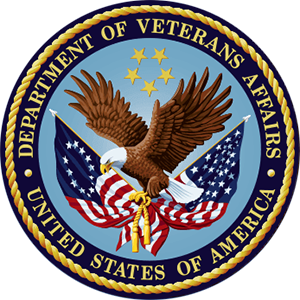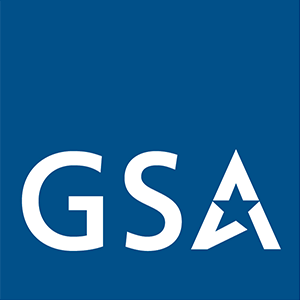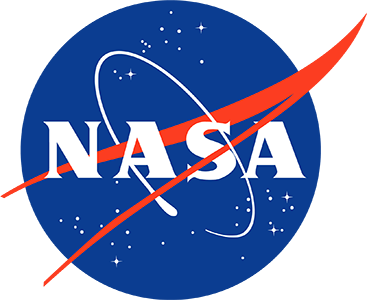Overview
Within This Page
Accessibility laws like the Architectural Barriers Act (1968), Section 504 of The Rehabilitation Act of 1973, the Fair Housing Act Amendments (1988), and the Americans with Disabilities Act (1990) establish minimum requirements that protect people with disabilities from discrimination in the built environment. Ron Mace, FAIA and Ruth Hall Lusher, saw the need to reevaluate using legal mandates to ensure usability by people with disabilities based on their experience with accessibility laws. Universal Design, the term for this revised approach, was based on the premise that the environment could be much more accessible than the minimum requirements of law required if designers focused attention on improving function for a large range of people.
At the broadest level, Universal Design is concerned with designing for diversity and equity.
Description
Definitions of Universal Design
Universal Design (UD) is also called inclusive design, design for all, or life span design. As initially conceived, UD was focused on usability issues. "The design of products and environments to be usable by all people, to the greatest extent possible, without the need for adaptation or specialized design" (Mace, 1985).
In the last ten years, the emphasis was broadened to wider issues of social inclusion. A newer definition is more relevant to all citizens without ignoring people with disabilities. It states that Universal Design is, "a process that enables and empowers a diverse population by improving human performance, health and wellness, and social participation" (Steinfeld and Maisel, 2012). In short, Universal Design makes life easier, healthier, and friendlier for all.
Universal Design increases the potential for developing a better quality of life for a wide range of individuals. It also reduces stigma by putting people with disabilities on an equal playing field. While it does not substitute for assistive technology, Universal Design benefits people with functional limitations and society as a whole. It supports people in being more self-reliant and socially engaged. For businesses and government, it reduces the economic burden of special programs and services designed to assist individual citizens, clients, or customers.
Proponents of Universal Design must recognize that products and environments can never be fully usable by every person in the world, but that services, management practices, and policies can benefit from Universal Design thinking. Universal Design should therefore be considered a process rather than an end state. There is never any end to the quest for improved usability, health, or social participation, so attention to more than just the built environment is needed to achieve these three broad outcomes.
Examples of UD features in buildings include automated doors, which provide an entrance for people of all abilities; integrated furniture components and power and communication systems that make outlets more convenient; and multi-sensory interactive wayfinding models that enable almost any person to comfortably operate and learn from a public map and directory system.
The following table provides some examples of the differences between Universal Design and accessible design.
| Universal | Accessible |
|---|---|
| A universally designed home plan costs the same as any other plan to build that anyone can purchase | A custom designed home based on an existing plan but requires additional costs for the redesign and custom construction details |
| Home improvement services that incorporate Universal Design as a basic service | Home modifications services by a contractor who charges more for her specialized knowledge of design for disability and aging |
| Automobile instruments and controls customizable to accommodate differences in perceptual abilities, stature, motor abilities, and preferences | Assistive technology used to adapt an automobile display for people with special needs |
| A no step building entry that everyone can use easily and together | A building entry with a ramp at the side that is out of the way for all visitors but is accessible by code |
| A hotel that has 100% universally designed rooms in a variety of types | A hotel that has only the code-required percentage of accessible rooms |
(Steinfeld and Maisel, 2012, p. 69)
Application
Principles of Universal Design
The "Principles of Universal Design" were developed by a team of U.S. experts organized by the Center on Universal Design at NC State University in the 1990's. Accompanied by a set of guidelines for each Principle, they were a valuable tool for clarifying Universal Design for early adopters.
The Principles of Universal Design:
- Equitable Use
- Flexibility in Use
- Simple and Intuitive
- Perceptible Information
- Tolerance for Error
- Low Physical Effort
- Size and Space for Approach and Use
Eight Goals of Universal Design
The eight Goals of Universal Design were developed in an effort to update the Principles, clarify the concept of Universal Design, incorporate human performance, health and wellness, and social participation as outcomes, and address contextual and cultural issues. For example, there are many sources of contextual differences, such as topography, economic development levels, cultural norms, and local values, which influence the way designers implement Universal Design. Increasingly, high value is placed on preserving cultural resources like historic buildings and natural resources. Attempts to enhance accessibility, however, often conflict with these two goals. Universal Design must address this conflict to overcome perceptions that it gets in the way of reaching other important design goals.
One barrier to adoption of Universal Design in middle- and low-income countries is the perception that it is often perceived as idealistic, expensive, or an imposition of Western values. It is realistic and appropriate to acknowledge that design strategies will differ or be adapted in different places and by different cultures. In some places, achieving the level of accessibility required by Western norms could be counterproductive. Thus, it is important that Universal Design strategies also address cultural values associated with social, economic, and physical context. In addition to addressing these concerns, the eight Goals of Universal Design were also conceived to link Universal Design to bodies of knowledge and identify measurable outcomes.
- Body fit. Accommodating a wide a range of body sizes and abilities
- Comfort. Keeping demands within desirable limits of body function
- Awareness. Insuring that critical information for use is easily perceived
- Understanding. Making methods of operation and use intuitive, clear, and unambiguous
- Wellness. Contributing to health promotion, avoidance of disease, and prevention of injury
- Social integration. Treating all groups with dignity and respect
- Personalization. Incorporating opportunities for choice and the expression of individual preferences
- Cultural appropriateness. Respecting and reinforcing cultural values and the social, economic and environmental context of any design project.
(Steinfeld and Maisel, 2012)
Expanding Adoption
Universal Design has not been adopted as extensively within the design community as some other recent design movements (e.g., sustainability, historic preservation). One challenge facing adoption is a continued perception of Universal Design as design for disability. To reach professionals, continuing education and the development of communities of practice, especially among educators, is a priority.
In addition, just as Leadership in Energy and Environmental Design (LEED) guidelines and a certification program were created in response to a population with greater demands for conservation of energy and material resources, a set of UD guidelines was needed for designers to adequately respond to an increasingly diverse population. The innovative solutions for Universal Design (isUD) program launched in 2018. Developed by a multidisciplinary group of UD experts, isUD contains more than 500 UD solutions related to commercial buildings, to help development teams achieve the Goals of Universal Design. isUD facilitates integrating UD at all stages of a project-from the design process to policies and practices (see thisisUD.com). The tool provides a step-by-step checklist for project teams to use in their quest for ongoing inclusivity. Design projects that utilize a sufficient number of solutions and submit appropriate documentation are eligible for isUD certification. While voluntary, isUD provides a comprehensive evidence-based approach to design that exceeds the minimum requirements of accessibility regulations, and is the only available tool to systematically evaluate UD in buildings.
Emerging Issues
As a result of UD's growing popularity, many new issues have captured the attention of design professionals and their colleagues in related professions. Those issues with a close relationship to Universal Design include aging in place, sustainability, workplace design, public spaces, and social justice. Universal Design has much to contribute to solving any social problem in which usability and social participation play a major role in design response.
Aging in Place: A large majority of individuals want to age where they currently live. Aging in place offers numerous social and financial benefits, and promotes keys to successful aging such as life satisfaction, health, and self-esteem. A 2021 AARP survey indicates about three-quarters of those 50+ would like to stay in their current homes or communities for as long as possible, compared to about half of those ages 18–49 who feel the same. In order to remain in their homes, 34% of older respondents recognize they may need to make physical changes to their house.
To remain in their own homes while aging, people need housing designs that can be adapted to wider range of health conditions than traditional designs allow. Encouraging housing producers to adopt Universal Design features is a key aspect of design for aging in place. This includes a no-step entry, bathrooms on an accessible floor level, potential for a sleeping space on an accessible level, good lighting, efficient space planning, and other features that reduce effort and accommodate short-term and chronic disabilities.
Common Aging-in-Place Features:
- One no-step path to a no-step entry that can be at the front, side, rear, or through a garage (1/4–1/2 in. thresholds)
- No step access to patios, balconies, and terraces (1/4–1/2 in. thresholds)
- Doorways have at least a 34 in. wide clear opening with appropriate approach clearances
- Door handles are 34–38 inches from the floor
- Hallways and passageways are 42 in. clear minimum
- Access to at least one full bath on the main floor with reinforced walls at toilets and tubs for the future installation of grab bars
- Cabinetry in kitchen that allows a person to work in a seated position
- Light switches and electrical outlets 24–48 in. from finished floor
- Stairways have tread widths at least 11 in. deep and risers no greater than 7 in. high
- Good lighting throughout the house including task lighting in critical locations (e.g. under kitchen cabinets)
- Non-glare surfaces
- Contrasting colors to promote good perception of edges and boundaries
- Clear floor space of at least 30 x 48 in. in front of all appliances, fixtures, and cabinetry
- Front-loading laundry equipment
- Ample kitchen and closet storage or adjustable shelving within 28–48 in.
- Comfortable reach zones
(Steinfeld and White, 2010).
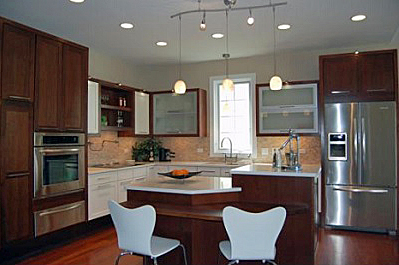
This image from the LIFEhouse™ shows many levels of lighting, multiple work center levels, and fixtures and appliances with Universal Design features. The home was the recipient of a National Association of Home Builders Gold Award for Best Universally Designed Home.
Sustainability: Sustainable products used in buildings need to be designed to be operable by people with limited function in order to comply with accessibility laws, but they also have to be usable for the broader population or they will not be effective in practice. Due to their novelty, they often present usability issues to end users. This can result in replacing the product and even abandoning the goal of sustainability. Acceptance of innovative sustainable products can be enhanced through Universal Design. Consider the example of a waterless urinal. Every men's restroom requires at least one lower urinal. Most waterless urinals are only designed for the higher, traditional position, which means that they may cause maintenance problems or even require an accessible, traditional water operated urinal to supplement the waterless unit. Some require special cleansers to protect the finish and special tools and procedures to change the trap. If not properly maintained, the urinal will cease to function, start emitting an odor, and anger building occupants and owners. Bad experiences like this can result in replacing the product and even abandoning the goal of sustainability.
Workplace: Universal Design is a critical consideration when designing workplace environments. Typically, adults spend a significant time working, thus making work environments important spaces in daily life (Sanford, 2012). People with disabilities, however, report being employed less than half as much as their non-disabled counterparts (Houtenville and Boege, 2020). The need for more accommodating work environments is gaining attention as the prevalence of disability and older adults in the workforce increases (Shore, Cleveland, and Sanchez, 2018; Taylor, 2018; Vespa, Armstrong, and Medina, 2018), and as work organizations increasingly strive to remove barriers to full participation of traditionally excluded groups such as racial, ethnic, and religious minorities, women, and, members of gender and sexual orientation minorities (Barak, 2016). With this growing diversity, organizational leaders have increasingly become aware of the importance of creating inclusive work environments (Nishii and Rich, 2014). Good design of the workplace can help increase participation of people with disabilities in the workforce, and can help to ensure that fewer accommodations will be needed if an employee has a disability. Additionally, achieving the highest level of usability in the workplace environment increases overall task efficiency, productivity, employee morale, and general safety, and also helps employers attract and keep a broad and diverse work force.
Common Workplace Features:
- All controls within the comfortable reach zone of between 24 inches (610 mm) and 48 inches (1220 mm) above the floor
- Ample and secure storage for employee's personal possessions within the comfort range of 24 inches (610 mm) and 48 inches (1220 mm) above the floor
- At least one automated door to the building, preferably one closest to employee parking or public transportation
- Counter heights for workstations should be adjustable to fit a work force with a wide range of statures and visual abilities
- Cubicles and other devices to give individual workers some control over noise
- Designated break areas that are quiet and comfortable, to allow workers a place to recover from work demands and socialize with others
- Height adjustable work surface between 28 inches (715 mm) and 32 inches (815 mm), with frequently used items stored within 24 inches (610) and 48 inches (1220 mm) and within a 24 inch (710 mm) maximum of reach arch from the elbow
- Sound absorbent materials on walls and floors to keep ambient noise levels as low as possible where background noise cannot be eliminated
- Storage containers that provide the option of carrying, pushing, pulling, or rolling
- Systems for employees to adjust light levels at their workspaces to best fit the requirements for their specific tasks, individual abilities, and preferences
- Wheeled chair with adjustable height seat, reclining tilt function, lumbar support, adjustable arm rests, and a high back to support neck and head
- Workstations situated so employees can communicate effectively with visual and/or verbal modes of communication
- Workstations that accommodate both standing and seated positions, also referred to as "sit-stand" workstations used wherever possible
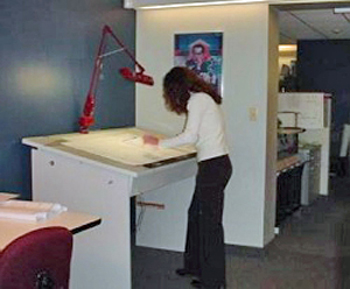
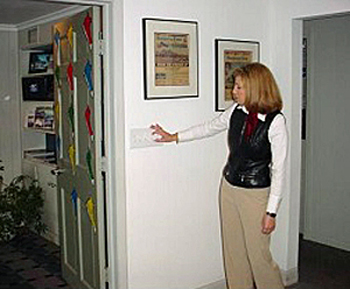
Provide workplace options (e.g., standing workstations) that enable employees to periodically get relief from the stress of standing or sitting for long periods of time, and work in an environment that is most productive for them.
Provide employees with access to environmental controls and light switches to allow them to adjust the temperature and light levels to best fit the requirements for their specific tasks, individual abilities, and preferences.
Public Spaces: Public spaces include facilities open to the public such as stores, restaurants, amusement parks, parks, and other recreation facilities, street rights-of-way, and transportation systems. Public accommodations are a critical domain for Universal Design because they are the site of key participation activities, including engagement in civic affairs, employment, recreation, education, and community mobility.
Common Universal Design Features in Public Spaces:
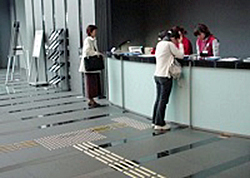
A tactile guide path in a museum helps all visitors find the information desk.
- Drinking fountains grouped with other amenities to make them easier to locate
- Directional signage/wayfinding cues throughout
- Lighting provided along outdoor pathways
- Nodes connected directly by pathways
- Resting places throughout the site
- Restrooms appropriately sized to support large numbers of users at the same time
- Signage placed within sight lines
- Signage in alternate languages, as well as in English
- Visual and tactile warning surfaces
- Walls, fences, and landscape features used for guidance to key destinations
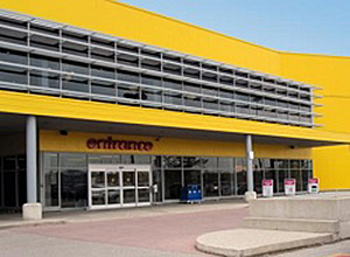
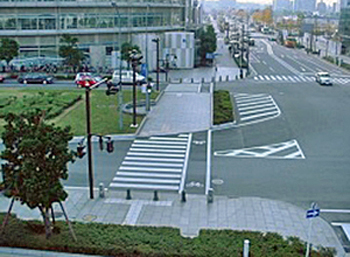
A store entrance with automated doors allows all customers to enter the same way.
Clear walkways, expanded corners, safety islands, and bike lanes enhance pedestrian, bicyclist, and driver safety.
Social Justice: Throughout the world, designers with a sense of social responsibility are concerned that good design, like many other resources of society, is a commodity that many cannot afford. Although initially focused on disability rights, Universal Design can focus on any civil rights issue because ultimately design for diversity is concerned with social justice for all. Thus, Universal Design should give attention to supporting access to housing, education, healthcare, transportation, and other resources in society for all those groups that have been excluded from full participation. Universal Design is particularly appropriate in the context of design for low-income minority groups, which often have higher rates of disability than the general population.

Hippo Water Roller. This design, inspired by a lawn roller, reduces the need for lifting and carrying and allows an individual to carry more water at one time (hipporoller.org)
Additional Resources
Organizations and Associations
American Association of Retired Persons (AARP)—A nonprofit membership organization dedicated to addressing the needs and interests of persons 50 and older. Through information and education, advocacy and service, AARP enhances the quality of life for all by promoting independence, dignity, and purpose. Among other things, AARP seeks to promote independent living and aging-in-place.
Center for Inclusive Design and Environmental Access (IDEA)—School of Architecture and Planning, University at Buffalo, Buffalo, NY—The Center engages in research and design focused on advancing equity and inclusion. It strives to improve the design of environments and products by creating person-centered tools, programs, and environments, and sharing these practices with change makers in universities, organizations, and communities.
Center for Inclusive Design and Innovation (CIDI)—The CIDI is dedicated to an inclusive society through innovations in assistive and universally designed technologies, with a goal of addressing the full range of needs for accessibility. CIDI is committed to the promotion of technological innovation and development of user-centered research, products, and services for individuals with disabilities.
Design for All Foundation—The Design for All Foundation is an international foundation that strives to develop, promote, research and disseminate Design for All among companies and organizations both at the public and private level, administrations, educational agents and also designers and professionals who intervene with the environment, products and services.
- Institute for Human Centered Design—The Institute for Human Centered Design (IHCD), founded in Boston in 1978 as Adaptive Environments, is an international non-governmental educational organization (NGO) committed to advancing the role of design in expanding opportunity and enhancing experience for people of all ages and abilities through excellence in design. IHCD's work balances expertise in legally required accessibility with promotion of best practices in human-centered or Universal Design.
Federal Agencies
- National Endowment for the Arts is an independent federal agency that funds and promotes artistic excellence, creativity, and innovation for the benefit of individuals and communities. The NEA funds and supports efforts that employ Universal Design concepts.
- National Institute on Disability, Independent Living, and Rehabilitation Research (NIDILRR) is a Center within the Administration for Community Living (ACL), Department of Health and Human Services (HHS). NIDILRR is a federal government grants-making agency that sponsors grantees to generate new disability and rehabilitation knowledge and promote its use and adoption. NIDILRR funds the only national research center on Universal Design. (Rehabilitation Engineering Research Center on Universal Design and the Built Environment)
Publications
- Inclusive Design: Implementation and Evaluation by Maisel, J., Steinfeld, E., Basnak, M., Smith, K., and Tauke, M.B. Oxfordshire, UK: Routledge, 2018.
- Inclusive Housing: A Pattern Book by Steinfeld, E., and White. J. W.W. Norton & Company, Inc., 2010.
- The Principles of Universal Design, Version 2.0 by The Center for Universal Design. North Carolina State University, April 01, 1997.
- Trends in Universal Design by The Delta Centre. Norwegian Directorate for Children, Youth and Family Affairs. 2013.
- PDF Download udny2.pdf" target="_blank">UDNY2 by Levine, D. (ed.). Center for Inclusive Design & Environmental Access, University at Buffalo, The State University of New York, 2003.
- Universal Design by Herwig, O. Germany: Birkhauser, 2008.
- Universal Design as a Rehabilitation Strategy by Sanford, J. New York: Springer Publishing Company, 2012.
- Universal Design: Creating Inclusive Environments by Steinfeld, E. and Maisel, J. Hoboken, NJ: Wiley, 2012
- Universal Design Handbook, 2nd Edition by Preiser, W. F.E. and Smith, K.H. (editors). New York, NY: McGraw-Hill Companies, 2010.
- Universal Design: The HUMBLES Method for User-Centered Business by Aragall, F. and Montana, J. England: Gower Publishing Ltd., 2012.
Articles
- The Living in Place Movement by Kelly Faloon. July 2014.
- "Supporting aging-in-place well: Findings from a cluster analysis of the reasons for aging-in-place and perceptions of well-being" by Ahn, Mira, Hyun Joo Kwon, and Jiyun Kang. Journal of Applied Gerontology 39.1, 3–15, 2020.
- "Understanding aging in place: Home and community features, perceived age-friendliness of community, and intention toward aging in place." By Choi, Yeon Jin. The Gerontologist 62.1, 46–55, 2022.
- "What is aging in place? Confusions and contradictions" by Forsyth, Ann and Molinsky, Jennifer. Housing Policy Debate 31.2 181–196, 2021.


